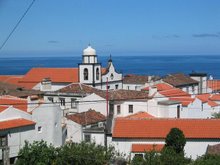
Espirito Santo - Holy Spirit (or Holy Ghost?) is difficult to explain but I'll try.
It's sort of the Church of Rome meets the Masons. Every village in the Azores has one or more imperios which look like churches but are actually meeting houses of brotherhoods of the Holy Spirit. Each imperio has its day a year for its brethren to march up the street with flags and carrying a crown (you can see the flags in this pic but the crown had already gone past). Someone's also banging a drum and there's chanting.
In a big town a Espirito Santo march is a traffic stopping major league event but here in Faja Grande, it's fairly low key and note how it doesn't prevent the march past pausing to have a chat with guys loading a cow into a truck.
Other aspects of Espirito Santo are that the imperio has a party night in the evening mostly involving playing bingo (of all the ungodly activities) and portions of freshly slaughtered beef are distributed to all houses in the village.
Apologies in advance if I've not explained this properly and/or caused any unintentional offence by wrongly describing it due to my ignorance.
It's sort of the Church of Rome meets the Masons. Every village in the Azores has one or more imperios which look like churches but are actually meeting houses of brotherhoods of the Holy Spirit. Each imperio has its day a year for its brethren to march up the street with flags and carrying a crown (you can see the flags in this pic but the crown had already gone past). Someone's also banging a drum and there's chanting.
In a big town a Espirito Santo march is a traffic stopping major league event but here in Faja Grande, it's fairly low key and note how it doesn't prevent the march past pausing to have a chat with guys loading a cow into a truck.
Other aspects of Espirito Santo are that the imperio has a party night in the evening mostly involving playing bingo (of all the ungodly activities) and portions of freshly slaughtered beef are distributed to all houses in the village.
Apologies in advance if I've not explained this properly and/or caused any unintentional offence by wrongly describing it due to my ignorance.




2 comments:
Rough draft translation [plus explanatory notes] of the pertinent excerpt from the "Festas" chapter in "A presença portuguesa na Califórnia" (by UCLA Emeritus professor Dr. Eduardo Mayone Dias), a book I'm currently translating with Diniz Borges for Portuguese Heritage Publications of California, which they plan to publish this fall.
= = = = = = = = = =
The Holy Ghost "cult" [movement dedicated to the third aspect of the Holy Trinity] is believed to have been brought to Portugal from Spain by Princess Isabel [also called Elizabeth] of Aragon – daughter of King Pedro III of Aragon and great-niece of Saint Elizabeth of Hungary [whose marriage was arranged to King Dinis in 1282, when he was 21 and she 11]. Franciscans in her retinue may have organized the first documented festa in Portugal, which took place in Alenquer, a village Dinis gave to his bride. This cult has almost totally disappeared from mainland Portugal since the mid-19th century although vestiges remain in Tomar (Festa dos Tabuleiros), Penedo (Serra de Sintra) and elsewhere, but it still retains an extraordinary presence in the Azores, from which it has been transplanted to emigrant communities.
Footnote: Queen Isabel is said to have devoted herself to helping the sick and poor, even secretly taking food from the royal larder to feed starving subjects against the express orders of her stern husband, King Dinis. Suspecting her defiance, the King confronted her one day when he caught her going out with her apron full. She lied, claiming to be carrying roses instead of food, so he demanded she open her apron in order to prove it – but, to the surprise of them both, out fell roses. The tradition of a free meal for all at Holy Ghost festivals commemorates Queen Isabel’s generosity. She is also celebrated as a peacemaker, and for founding charities and hospitals.
P.S. See recipe for Holy Ghost Sopas and other traditional dishes, adapted for household-size quantities:
http://www.sfgate.com/cgi-bin/article.cgi?f=/c/a/2004/06/09/FDGL571V951.DTL
I prefer "couves portuguesas" (young tender kale grown in the typical Portuguese "quintal" [kitchen garden]) to regular light green Dutch (head) cabbage. Some impérios in the Azores and California serve the kale chopped in a serving bowl alongside the sopas. But last May in Calheta, São Jorge, I had it where they had stacked up several leaves, rolled them up, then sliced them (though I don't know whether the kale rolls were sliced before or after cooking, but a neighbor of yours in FG might know). I have my doubts about the tomato sauce called for in this version, and you might also like use more fresh mint (both are your call). I also like boiled potatoes with Sopas, which some communities serve.
Besides Sopas, the other recipes in the above article are for Spice Cookies, Rice Pudding and Fava Bean Stew With Linguiça.
Post a Comment